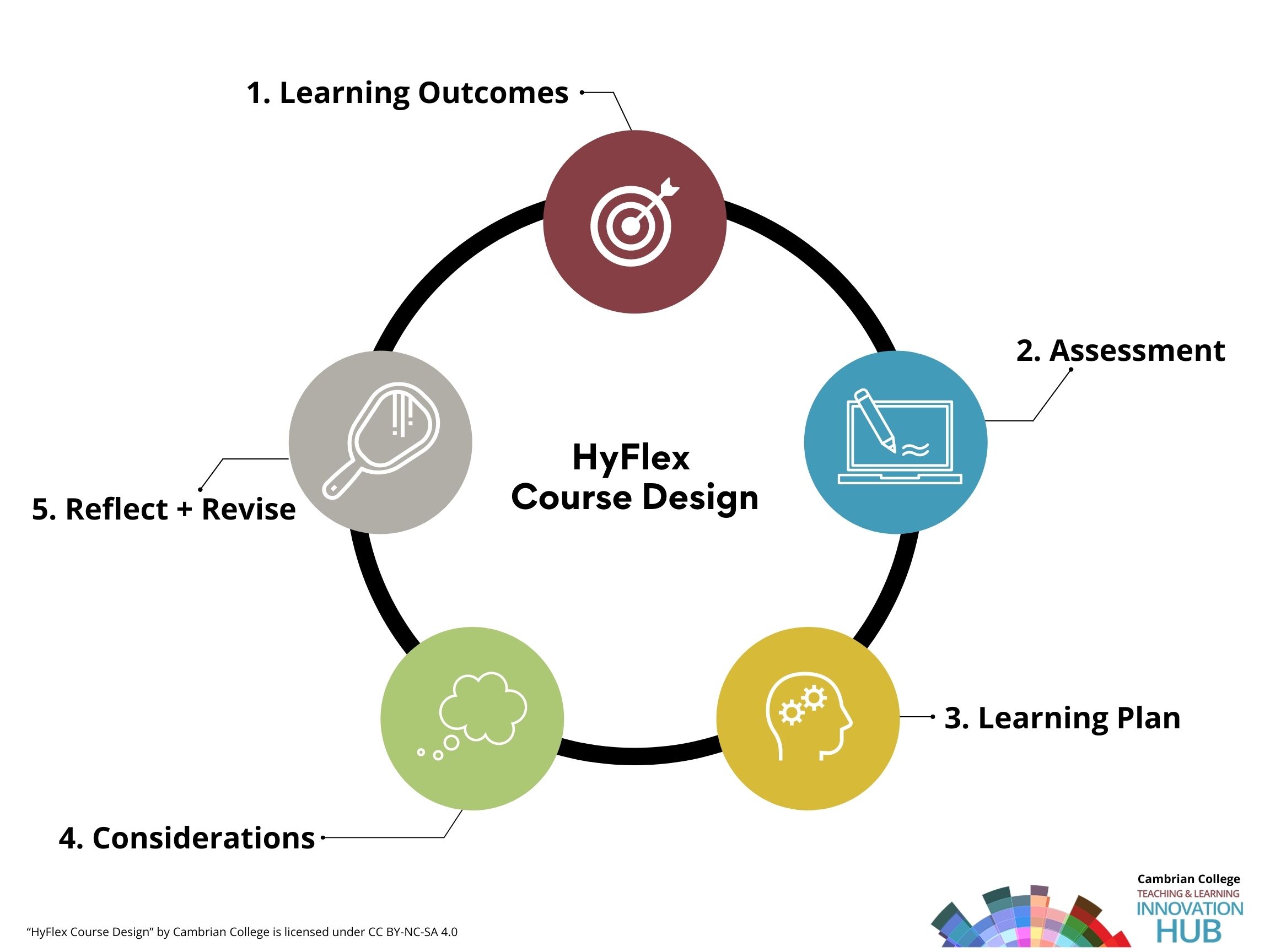Unit 1: What is HyFlex?

Let’s start at the beginning…
Hybrid-Flexible delivery (coined HyFlex) was developed by Brian J. Beatty at San Francisco State University in 2005 in response to enrollment concerns; specifically, that a successful residential Masters of Arts (MA) program needed to attract a broader diversity of students and provide more participation options for current students (Beatty, 2019).
The suggestion was made to move the MA program completely online, but Beatty and his colleagues faced a range of barriers that would prevent the development of a fully online program, including lack of institutional support, lack of faculty experience teaching online, and a perceived lack of support from enrolled students that were located regionally. The conundrum of how to continue offering a fully in-person program with the additional opportunity to take the program fully online seemed out of reach.
Beatty and his colleagues researched blended and hybrid models used in higher education to see if a design model already existed. Although the research provided them with great advice, they thought a traditional blended learning approach wouldn’t quite capture the delivery mode they were envisioning.
Beatty experimented with some delivery options for both synchronous (in-person and online) students and asynchronous students in his courses over a few terms, with students providing valuable feedback as ‘design partners’ (Beatty, 2019).
By allowing students to attend classes synchronously or asynchronously at any given time without forfeiting the quality of the learning experience, Beatty had, in essence, created a new delivery mode: HyFlex.
In Beatty’s HyFlex course, students can choose to participate in any mode:
- Face-to-face, in-class, in-person (in a classroom on campus)
- Synchronous online via video conferencing during the in-person class
- Asynchronous online in the learning management system (LMS)
The beauty of HyFlex is that students can move fluidly between modes.
HyFlex allows participation in any mode of delivery throughout the semester according to student wants, needs, and schedules. Because of this, it is recommended to plan HyFlex courses well in advance, starting with the asynchronous mode and by using high-quality instructional materials, learning activities, and engagement strategies.
In this unit, you will learn the considerations needed to begin planning an effective and engaging HyFlex course.
Start planning with the end goal
When starting to develop HyFlex courses, it is recommended to use a backward design. In the book Understanding by Design, Grant Wiggins and Jay McTighe outline a framework for designing courses using this strategy.
In backward design, the instructor starts with the end in mind by determining learning outcomes that describe what the learner will know or be able to do by the end of the course. After the learning outcomes have been determined, the instructor identifies the assessments that evaluate whether a learner has met those outcomes.
Once the outcomes and assessments are determined, the instructor starts to build the learning plan, including instructional materials (content) and learning activities (engagement) (Wiggins and McTighe, 2005). It is vital that HyFlex courses are intentionally designed using a backward design approach well in advance of the start of the semester.
The following 5-minute video provides a good overview of Backward Design and how focusing on the “destination” in the course creates a more engaging and meaningful experience.
About Backward Design [5:16] Video Transcript [.docx]
Consider all the pieces to the HyFlex puzzle

When designing a HyFlex course, try this process:
Step 1. Learning Outcomes: Identify what the learner should know and/or be able to do by the end of the course.
Step 2. Assessment: Identify assessments that evaluate whether the learner met the outcome(s).
Step 3. Learning Plan: Identify the topics/units and instructional materials to be included in each. Identify learning activities to engage students in the content.
Step 4. Considerations: Consider how instructional materials, learning activities, and assessments will be experienced by learners in each delivery mode.
Step 5. Reflect + Revise: At the end of the semester, reflect on what worked and what didn’t work; revise as needed.
Adopt Beatty’s Four Fundamental Values for HyFlex

Beatty outlines four fundamental values that an instructor should consider when designing a HyFlex course.
In module 2, you will learn more about how these values relate to lesson planning. For now, consider how you can apply them in the early stages of course design.
Learner Choice: Learners choose between participation modes daily, weekly, or topically.
It is vital that students understand how HyFlex courses are set up, expectations in HyFlex environments, and the fluidity in moving between the different delivery modes at any given point in the semester.
Equivalency: Activities in all participation modes lead to equivalent learning outcomes.
Students in any delivery mode should experience the same quality of instructional materials, learning activities, and assessments. They don’t need to be the same; they need to be of equivalent quality depending on the delivery mode.
Reusability: Reuse artifacts from learning activities in each participation mode for all students.
Where possible, design instructional materials and learning activities that can be used across all modes of delivery.
Accessibility: Provide equitable access to all participation modes (Beatty, 2019).
It is important to note here that all instructional materials, learning activities, and resources should be accessible according to accessibility laws in your location.
Consider these additional core principles
In addition to Beatty’s fundamental values, there are a few other core principles to contemplate: the organization of the materials within the course, the use of a predictable and consistent format, and the implementation of the course content and assessments.
Organization refers to the advanced work that goes into building a course and working through some practical and theoretical challenges that stem from having different modes of students participating in the same course.
Predictability refers to creating an environment where learners and the instructor understand the nuances of how students in all modalities are expected to engage with the course.
It also means designing elements, like learning objects, that work for all modalities, giving course participants a predictable way of engaging with the material.
Consistency refers to class policies and rules, like how group work is conducted. For instance, can students participate in groups outside of class time asynchronously or are required to meet synchronously?
Due to the flexible nature of HyFlex courses, it is important to set the “ground rules” for how the course will operate and follow through consistently throughout the course.
 Activity
Activity
The following resources provide excellent tips about HyFlex course planning.
As you listen and read, identify strategies or recommendations that stand out to you and consider how you would use them for your own HyFlex course.
Ask important questions as you plan
The critical element of HyFlex is that students are able to take advantage of the flexible course structure to best suit their learning style and availability. This is a huge advantage for students who have to work during class time, have other responsibilities like childcare, are in a different time zone, etc.
Often, the initial impetus for developing a HyFlex approach is to serve both online and in-person students with a limited set of resources (time, faculty, space), leading to a multi-modal delivery solution.
That said, there are a number of considerations to examine before fully adopting HyFlex:
If your institution plans to adopt HyFlex, start with manageable goals.
As an institutional approach, try switching over a few ‘high need’ programs into HyFlex. Then, focus on support for those instructors and students to ensure successful execution.
After the first round of HyFlex deliveries, you will know what worked well and what didn’t. It is important to meet with your program teams and administration to debrief and to make revisions for the next delivery.
With this approach, your institution may feel more comfortable increasing its HyFlex delivery options in the future.
Myth-busting for HyFlex
Because HyFlex courses focus on hybrid and flexible delivery, there can be confusion about what HyFlex is and what it is not.
It is important to set expectations and policies for the class so that students understand how they may interact within the course and what sets it apart from other modalities. HyFlex is primarily about giving students choice in how to attend class by developing class delivery and learning objectives that align with this philosophy.
Below, we will explore four common misconceptions about HyFlex.
Myth #1: Asynchronous components of HyFlex courses are self-paced.
No, the asynchronous components of a HyFlex course aren’t meant to be self-paced. Many asynchronous activities in HyFlex encourage participation between students in different delivery modes.
For example, if you have a discussion in class, you may direct a few students to capture the main ideas to a discussion forum in the LMS. You may then invite students in the asynchronous delivery mode to contribute their thoughts, and share those thoughts with the synchronous students for the next class.
So while asynchronous students may not be working at the exact same time as their face-to-face and online synchronous peers, it is still recommended that asynchronous students complete work within specified time constraints.
Myth #2: Attendance policies (or expectations) are not needed.
Although attendance can be flexible, there should still be participation expectations in the course. Completing activities or other forms of attendance can still be required.
For example, mandatory viewing of lecture videos or an equivalent mechanism for content delivery can be required within a specified time frame, like during the week in which the face-to-face class occurs.
Myth #3: There are no deadlines for graded materials.
Although students participate in different ways, deadlines for graded materials are the same for all students, no matter how they interact with the class.
Myth #4: Learning materials in the LMS are only meant for asynchronous students.
Learning resources in the LMS can be accessed and used by all students. For example, a recorded lecture can be uploaded to the LMS and used by students of all modalities.
Students who participate in the class face-to-face and synchronously can use videos of the class to review and reinforce their learning.
Beyond video, there are many asynchronous activities in which all students can engage, such as practice quizzes, interactive learning objects, discussion forums, etc.
Unit Summary
Complete the short quiz below to review the main takeaways from this unit.

